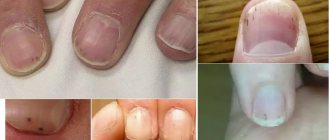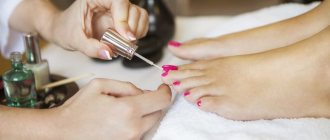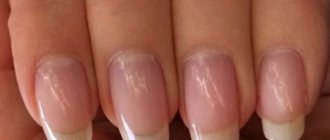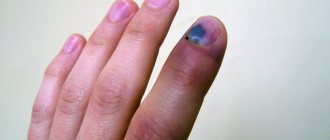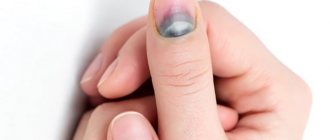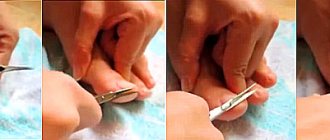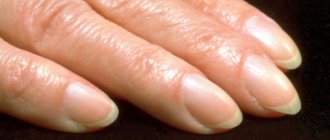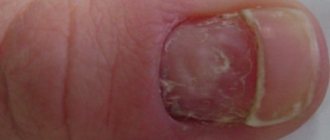Why do nail plates turn blue?
If you notice that you have a bruised nail on your big or other toe, the sooner you determine the cause of its appearance, the sooner you can begin treatment. The reason for the appearance of blueness can be quite serious, and medical help cannot be avoided. The following explains why the nail plate on the big or other toe may turn blue:
- Trauma . If you hit the nail plate, then due to the impact and damage to the tissue, a black or blue hematoma may form on it.
- Wearing tight and uncomfortable shoes . Leads to the formation of a bruise.
- Infection . With fungal infections, blue nails often occur.
- Poor circulation . It is considered one of the first reasons for a blue fingernail. First of all, the area under the nail darkens, then the bruise can spread to the skin of the finger.
- Melanoma . This is a malignant tumor that is very rare.
Causes of blue nails
One or several nails can suddenly turn blue - from the cold or when hit. In addition, a similar phenomenon can occur immediately and progressively, with the appearance of additional symptoms, which most often occurs with internal diseases. There may be several reasons for this process:
- A fungal infection that can progress both internally and externally.
- Uncomfortable, tight shoes made from low-quality synthetic materials.
- Mechanical damage. For example, a blue nail after a blow is not uncommon. Pinched fingers also fall into this category.
- Frostbite or prolonged exposure to low temperatures on unprotected areas of the hands.
- Diseases of the respiratory, nervous and cardiovascular systems.
- Failure in the metabolic system and microelements (most often such as copper).
- Intoxication with aggressive chemicals through prolonged contact with them.
- Allergic reactions to low-quality cosmetics, long-term contact with varnishes, gel polishes, substances included in nail extensions.
- Raynaud's syndrome is extremely rare.
- An even rarer cause of blue nails is melanoma. This is a malignant formation that consists of darkly pigmented cells called melanocytes.
Correct diagnosis is the key to a quick and successful recovery. Now let's take a closer look at the reasons.
Accompanying symptoms
Blue discoloration of the nail plate may be accompanied by the following symptoms:
- A form of cardiovascular failure. In this case, accumulation and stagnation of blood occurs in the lower extremities. The situation is very dangerous and requires special attention and urgent contact with a specialist.
- Aching pain in the nail area can be caused by mechanical damage received by a person due to improperly selected shoes, playing sports, or due to a strong blow. In these situations, the vessels begin to burst and a hematoma forms. Most often, the little finger and thumb are at risk of injury, due to their location.
- Pathological infection of the nail plate by a fungus, which can occur with low immunity.
- Damage during removal of hangnails, resulting in infection, unpleasant odor, and itching.
- Some forms of lung cancer.
- Toxic poisoning of the body, including poisoning with drugs and household chemicals that the liver could not cope with (hemochromatosis).
- Diseases of the respiratory system, asthma and bronchitis, can, in the acute phase, lead to oxygen starvation and a blue color of the plates.
Why does a toenail turn blue and how to treat it?
Typically, why a toenail turns blue can be explained by repeated trauma over time, such as the constant “collision” of your toes and the toe of your shoe. And sometimes this can be the result of a one-time, sudden, traumatic injury to the foot (for example, a heavy object fell on the foot).
- Damaged blood vessels cause the nail to change color to black, blue and purple.
- This condition is not very attractive, but is not always painful. However, if there is a lot of blood, it will create unpleasant pressure.
- Sometimes there is an unpleasant odor.
- Less commonly, you may have serious damage to the nail bed, a laceration, or even a broken bone. Damage like this makes you an easy target for infections and other complications.
When to see a doctor?
If the injury is minor and the nail has slightly changed its color, then it is not necessary to contact a specialist. Over time, he will rehabilitate himself. If there is no unpleasant odor and the nail plate does not hurt, it is recommended to disinfect the nail plate every day.
If the injury is more serious, the nail turns blue, which is accompanied by pain and discomfort, then in this case you should contact a specialist immediately; the sooner the cause of the appearance of dark spots is determined, the more effective the treatment will be. A quick and correct diagnosis will help speed up recovery.
Treatment
If, upon examination by a specialist, no abnormalities in the functioning of the body were detected, then treatment can be carried out at home. In this case, both medications and folk remedies are provided:
- In case of injury or bruise, it is recommended to use ice or any other cooled product that can reduce the formation of bruises in the event of a bruise. If the pain is severe, you can use painkillers or ointments. For bruises, an elastic bandage is also used.
- If the nail is damaged due to cosmetics, you must wait for the natural color change of the nail, and also be careful with low-quality decorative cosmetics.
- If the extremities are frostbitten, it is necessary to urgently begin warming measures, these could be: warm baths, rubbing with warming agents.
- When wearing tight and uncomfortable shoes, blood flow may decrease, which can cause bruising. In order to increase blood flow, it is recommended to take a foot bath with sea salt; this procedure should last at least 20 minutes. You can also add aroma oils to the bath and perform a restorative foot massage using this oil.
- During periods of elevated temperature, the extremities of the legs and arms become cold, as a result of which the nails turn blue. This is due to spasm of blood vessels, which can disrupt the body’s heat exchange during high temperatures. In such a situation, first of all, you should take a tablet, for example, No-Shpu, the dosage is recommended to be determined by age category. Afterwards, start rubbing your arms and legs in order to disperse the blood through the veins, and add a warm, generous drink.
- Vitamin complex. Many experts advise taking it for general strengthening of the nail plate.
Unfortunately, in most cases, blue nails can be caused by serious problems in the body.
What to do if your nail turns blue
If a patient’s nails are blue due to something other than simple pinching of the arms or legs, then you should see a doctor. He will assess the patient’s condition and prescribe treatment. If the blueness of the fingernails is associated with injury, congestion or chemical exposure, you can simply apply ice to the hematoma or bruise. This will reduce the pain and make the patient feel much better. If the blue color on the nails is caused by incompletely removed varnish (corrosive pigment), then you can restore the shade of the plate using the following methods:
- Salt baths - add a tablespoon of sea salt to a glass of water; if desired, you can add baking soda on the tip of a knife. Immerse your nails in the bath for 10-15 minutes, repeat if necessary.
- Cut a slice of lemon, immerse the slices in its juice, leave for 5 minutes, and rinse off the residue with water. Repeat until the blue discoloration is eliminated.
Hand massage will help to cope with the blue color of the plates, it improves the functioning of blood vessels and stimulates healthy nail growth. Blue feet are often the reason for wearing tight, uncomfortable shoes . You can change it to the appropriate size to get rid of the problem and normalize the functioning of blood microflow in the extremities. You can eliminate other causes of blue color using the following methods:
- temporarily stop using varnishes and nail polish removers;
- replenish the supply of vitamins and minerals in the body (start taking nutrient complexes) to strengthen the immune system;
- prevent the effects of cold temperatures (do not wash your hands in cold water, do not go outside in winter without gloves or mittens).
If the blue color or cyanosis of the nails is caused by heart failure, you need to take a course of medications that support heart function. When the bruise is caused by a hematoma and it does not go away on its own, the doctor may prescribe nail removal or tissue puncture:
- A local anesthetic (Lidocaine, Novocaine) will be administered. The plate will be removed to examine the nail bed. The area underneath is cleaned, if tissue is damaged, it is washed, and if necessary, sutured.
- If the patient does not want to remove the blue nails, the doctor can pierce them with a sterile needle to remove the liquid. Then the hole is burned out with a special device, and a tight bandage is applied to the wound treated with an antiseptic. To speed up healing, it is recommended to take warm baths with Epsom salts twice a day for 10-15 minutes. Afterwards, an antibiotic ointment is applied to the plate, and a dry sterile bandage is applied. Recovery will take 2-3 weeks; if the entire nail is removed, it will take up to three months.
If the cause of cyanosis is a fungus, then you should undergo antifungal treatment. It includes daily steaming of nails in a warm soap or salt bath, scraping off dead cells and applying antimycotic agents (drops, sprays, thick ointments or solutions, under an occlusive dressing).
Article on the topic: Treatment of dry eye syndrome - effective eye drops, ointments and folk remedies
In case of frostbite, you should immediately consult a doctor for help so that the damaged tissue does not die and the condition does not lead to purulent infection and sepsis. In the first stages of frostbite, restorative therapy and treatment of the skin and nail plate with antibiotics are indicated . In advanced cases, it is possible to remove the nail to prevent the development of gangrene and blood poisoning.
Outcome of the problem in the absence of treatment
If the nail plate is left untreated, its recovery can take a long time and lead to serious problems. Lack of treatment can lead to serious consequences, such as:
- nail deformation;
- limitation of motor function;
- swelling;
- the presence of purulent discharge;
- specific smell;
- shooting and aching pain.
If the pathology provokes the appearance of a fungus, self-medication is contraindicated; in this case, only a specialist can help.
The doctor must prescribe the necessary procedures, medications and wellness manicure. In order to speed up the healing process of the nail, it is necessary to include in the diet foods that contain large amounts of calcium, and periodically take baths with salt. These procedures will help normalize the pressure in the area of the diseased area, and the blood will gradually begin to flow out of the nail plate.
What to do for prevention?
The best cure for a disease is prevention . In order not to encounter various diseases of the nail plate and prevent the appearance of dark spots, it is recommended to adhere to the following rules:
- Choose high-quality and comfortable shoes made from natural materials.
- It should not squeeze or cause discomfort when worn.
- When processing your nails, be careful not to damage the cuticle; it is recommended to trim it very carefully and not too much.
- When using varnishes, you should pay attention that they do not contain aggressive impurities.
- Hygiene. Keep your feet clean and dry.
- Regular airing of shoes.
- Avoid frostbite. If your feet become hypothermic, you should immediately warm them up.
Blue nails are not considered an independent disease. In most cases, it manifests itself as a cause indicating a problem in the body.
Root causes of manifestation
Nails can turn blue for various reasons. Sometimes this is due to various ailments, including fungus or diabetes. Although most often the blueness of the nail is a normal reaction of the body to frostbite or blow.
Sometimes a change in the color of the nail plate is not at all a consequence of mechanical influences. If you hit, fall, or get injured, your nail may actually turn blue. However, if a person has not noticed such mechanical effects, then you need to look for the cause of the manifestation, and together with your doctor.
Often, nails turn blue due to wearing uncomfortable, tight shoes. Constant pressure provokes poor circulation directly in the tissues of the finger. As a result, blood does not flow well into the nail bed. But the big toe has quite large vessels. Therefore, the lack of their blood supply is fraught with serious consequences, including thrombosis and even gangrene.
Blue discoloration of the nail is sometimes caused by an artisanal pedicure. So, if the cuticles are handled inaccurately, that is, excessive cutting or pushing back, the nail fold is damaged. Such interference is dangerous. The nail will become bluish and acquire a wavy structure.
The use of cosmetics also has an effect. For example, low-quality nail polish, nail polish remover, scrubs or creams can damage the structure of the nail plate. It will turn blue and begin to crumble. Work that involves systematic contact with chemicals leads to similar consequences. Typically, such workers' nail plates become brittle and sometimes bleeding develops.
